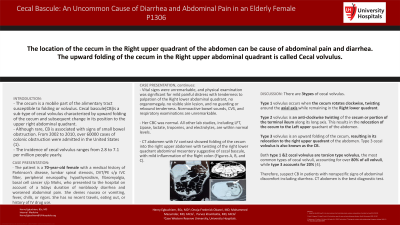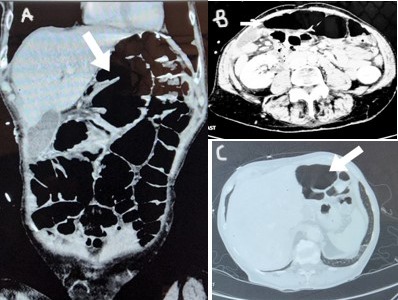Sunday Poster Session
Category: Small Intestine
P1306 - Cecal Bascule: An Uncommon Cause of Diarrhea and Abdominal Pain in an Elderly Female
Sunday, October 22, 2023
3:30 PM - 7:00 PM PT
Location: Exhibit Hall

Has Audio
- HE
Henry Egbuchiem, Bsc, MD
University Hospitals Geauga Medical Center
Chardon, OH
Presenting Author(s)
Henry Egbuchiem, Bsc, MD1, Nkemputaife Onyechi, MD2, Joseph Amoah, MD1, Mohammed Mazumder, MD, FACG1, Parvez Khambatta, MD, FACG1
1University Hospitals Geauga Medical Center, Chardon, OH; 2University Hospitals, Chardon, OH
Introduction: The cecum is a mobile part of the alimentary tract susceptible to folding or volvulus. Cecal bascule(CB)is a sub-type of cecal volvulus characterized by upward folding of the cecum and subsequent change in its position to the upper right abdominal quadrant. Although rare, CB is associated with signs of small bowel obstruction. From 2002 to 2010, over 60000 cases of colonic obstruction were admitted in the United States (1). The incidence of cecal volvulus ranges from 2.8 to 7.1 per million people yearly.
Case Description/Methods: The patient is a 70-year-old female with a medical history of Parkinson’s disease, lumbar spinal stenosis, DVT/PE s/p IVC filter, peripheral neuropathy, hypothyroidism, fibromyalgia, basal cell cancer s/p Mohs, who presented to the hospital on account of a 5days duration of nonbloody diarrhea and worsened abdominal pain. She denies nausea or vomiting, fever, chills, or rigors. She has no recent travels, eating out, or history of IV drug use. Vital signs were unremarkable, and physical examination was significant for mild painful distress with tenderness to palpation of the Right lower abdominal quadrant, no organomegaly, no visible skin lesion, and no guarding or rebound tenderness. Normoactive bowel sounds, CVS, and respiratory examinations are unremarkable. Her CBC was normal. All other lab studies, including LFT, Lipase, lactate, troponins, and electrolytes, are within normal levels. CT abdomen with IV contrast showed folding of the cecum into the right upper abdomen with twisting of the right lower quadrant abdominal mesentery suggestive of cecal bascule, with mild inflammation of the Right colon (Figures A, B, and C).
Discussion: There are 3types of cecal volvulus. Type 1 volvulus occurs when the cecum rotates clockwise, twisting around the axial axis while remaining in the Right lower quadrant. Type 2 volvulus is an anti-clockwise twisting of the cecum or portion of the terminal ileum along its long axis. This results in the relocation of the cecum to the Left upper quadrant of the abdomen. Type 3 volvulus is an upward folding of the cecum, resulting in its relocation to the right upper quadrant of the abdomen. Type 3 cecal volvulus is also known as the CB. Both type 1 &2 cecal volvulus are torsion type volvulus, the most common types of cecal volvuli, accounting for over 80% of all volvuli, while type 3 accounts for 20% (4). Therefore, suspect CB in patients with nonspecific signs of abdominal discomfort including diarrhea. CT abdomen is the best diagnostic test.

Disclosures:
Henry Egbuchiem, Bsc, MD1, Nkemputaife Onyechi, MD2, Joseph Amoah, MD1, Mohammed Mazumder, MD, FACG1, Parvez Khambatta, MD, FACG1. P1306 - Cecal Bascule: An Uncommon Cause of Diarrhea and Abdominal Pain in an Elderly Female, ACG 2023 Annual Scientific Meeting Abstracts. Vancouver, BC, Canada: American College of Gastroenterology.
1University Hospitals Geauga Medical Center, Chardon, OH; 2University Hospitals, Chardon, OH
Introduction: The cecum is a mobile part of the alimentary tract susceptible to folding or volvulus. Cecal bascule(CB)is a sub-type of cecal volvulus characterized by upward folding of the cecum and subsequent change in its position to the upper right abdominal quadrant. Although rare, CB is associated with signs of small bowel obstruction. From 2002 to 2010, over 60000 cases of colonic obstruction were admitted in the United States (1). The incidence of cecal volvulus ranges from 2.8 to 7.1 per million people yearly.
Case Description/Methods: The patient is a 70-year-old female with a medical history of Parkinson’s disease, lumbar spinal stenosis, DVT/PE s/p IVC filter, peripheral neuropathy, hypothyroidism, fibromyalgia, basal cell cancer s/p Mohs, who presented to the hospital on account of a 5days duration of nonbloody diarrhea and worsened abdominal pain. She denies nausea or vomiting, fever, chills, or rigors. She has no recent travels, eating out, or history of IV drug use. Vital signs were unremarkable, and physical examination was significant for mild painful distress with tenderness to palpation of the Right lower abdominal quadrant, no organomegaly, no visible skin lesion, and no guarding or rebound tenderness. Normoactive bowel sounds, CVS, and respiratory examinations are unremarkable. Her CBC was normal. All other lab studies, including LFT, Lipase, lactate, troponins, and electrolytes, are within normal levels. CT abdomen with IV contrast showed folding of the cecum into the right upper abdomen with twisting of the right lower quadrant abdominal mesentery suggestive of cecal bascule, with mild inflammation of the Right colon (Figures A, B, and C).
Discussion: There are 3types of cecal volvulus. Type 1 volvulus occurs when the cecum rotates clockwise, twisting around the axial axis while remaining in the Right lower quadrant. Type 2 volvulus is an anti-clockwise twisting of the cecum or portion of the terminal ileum along its long axis. This results in the relocation of the cecum to the Left upper quadrant of the abdomen. Type 3 volvulus is an upward folding of the cecum, resulting in its relocation to the right upper quadrant of the abdomen. Type 3 cecal volvulus is also known as the CB. Both type 1 &2 cecal volvulus are torsion type volvulus, the most common types of cecal volvuli, accounting for over 80% of all volvuli, while type 3 accounts for 20% (4). Therefore, suspect CB in patients with nonspecific signs of abdominal discomfort including diarrhea. CT abdomen is the best diagnostic test.

Figure: CT abdomen with IV contrast was significant for folding the cecum into the right upper abdomen with swirling and twisting of the right lower quadrant abdominal mesentery suggestive of cecal bascule, with mild inflammation of the Right colon (figure A, B, and C).
Disclosures:
Henry Egbuchiem indicated no relevant financial relationships.
Nkemputaife Onyechi indicated no relevant financial relationships.
Joseph Amoah indicated no relevant financial relationships.
Mohammed Mazumder indicated no relevant financial relationships.
Parvez Khambatta indicated no relevant financial relationships.
Henry Egbuchiem, Bsc, MD1, Nkemputaife Onyechi, MD2, Joseph Amoah, MD1, Mohammed Mazumder, MD, FACG1, Parvez Khambatta, MD, FACG1. P1306 - Cecal Bascule: An Uncommon Cause of Diarrhea and Abdominal Pain in an Elderly Female, ACG 2023 Annual Scientific Meeting Abstracts. Vancouver, BC, Canada: American College of Gastroenterology.
